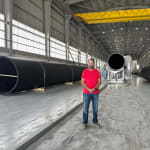
Only 5 mm wall thickness deviation with a pipe diameter of 2.7 m Extrusion technology from battenfeld-cincinnati makes it possible. After all, there is no other machine manufacturer in the world that has so much in the design of complete large-diameter pipe extrusion lines and has installed as many lines internationally as the German-Austrian company. The most recent record-breaking lines for large PE pipes up to 2,7 m in diameter were recently installed at two customers in Egypt and are running to the customer's satisfaction. The first projects have already been implemented.
“The quality and precision of the large-diameter pipes we achieve on the new line from battenfeld-cincinnati is excellent,” says Ahmed El Mahalawy, owner of Plastic Pipes & Products Co. (PPP) in Cairo, praising the supplier of the new complete line. The Egyptian pipe manufacturer PPP has just completed a project with large-diameter pipes in Oman: high-quality pipes transport seawater to a desalination plant - an ideal application for plastic pipes, which score points here with their corrosion resistance. It is also an ideal application for large-diameter pipes, as large quantities of water can be transported efficiently in the shortest possible time.
It is usually the material costs that enable the most money to be saved in the production of large-diameter pipes. “The main focus of our technology lies in the reduction of wall thickness tolerances. Thanks to numerous optimizations of the individual components of the system, we can now easily achieve values that correspond to half the DIN standard,” explains Andreas Türk, Sales Director at battenfeld-cincinnati. The dimensional accuracy and minimized wall thickness deviations alone mean that one line can save more than 1 million euros in raw material costs per year compared to conventional lines and deviations. “Further advantages of our technology are the high output rates of two tons and more per hour, the lifespan of our systems, which are designed for 20 to 25 years, and their low energy consumption. This means that an investment pays for itself within a very short time,” says Andreas Türk.
The benefits described are based on the process engineering design of the overall system, in which all individual components are perfectly coordinated, and a modern and intuitive control system ensures reliable inputs and configurations. The melt temperature plays a major role in the extrusion of large-diameter pipes, as this is the main cause of unwanted sagging. Andreas Türk explains: “The lower the temperature of the PE melt, the more viscous it is, and the less sagging occurs. The less sagging, the better the pipe quality and wall thickness distribution.” In the extruder itself, a solEX NG, the combination of a spiral grooved barrel and matching screw and grooved bushing geometry ensures high specific output rates at low screw speeds and therefore low melt temperatures. Compared to previous extruders, the melt temperature is around 10 °C lower. A further temperature reduction of around 10 °C is achieved with the OptiMelt active melt cooling system. This powerful melt cooler is installed between the extruder and the mold. Furthermore, the two-stage VSI pipe head, a combination of spiral mandrel distributor and screen basket patented by battenfeld-cincinnati, guarantees uniform melt distribution in the pipe and thus ensures uniform cooling and extremely narrow wall thickness distributions. Thanks to the sophisticated concepts of all individual components, the high-quality large-diameter pipes can be produced in an energy-efficient manner. All downstream units, which are designed for a wide range of pipe not dimensions up to 2.7 m, can manage with low energy and water consumption, contribute to this. In the vacuum and cooling tanks, the pipe can also be cooled individually in sections around the circumference. This option can also further improve the wall thickness distribution and minimize ovality.



